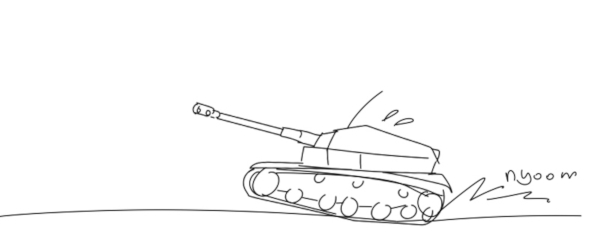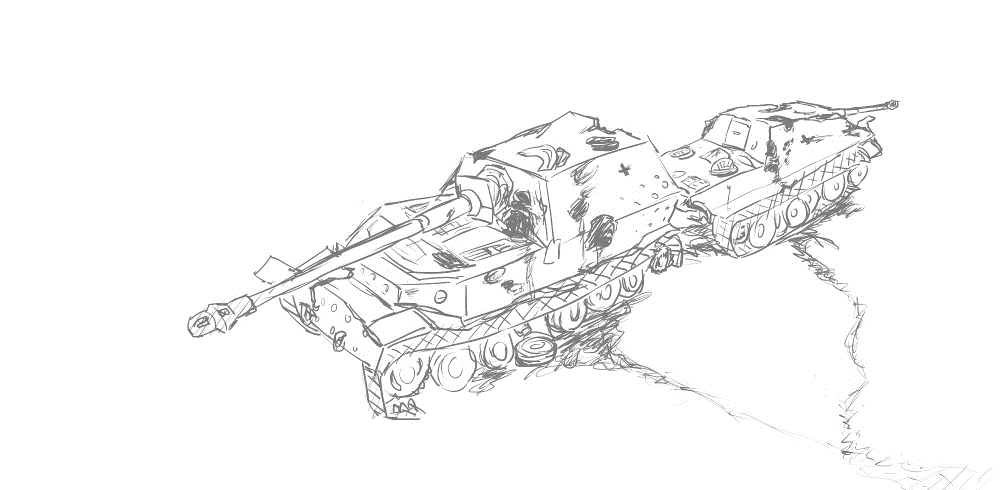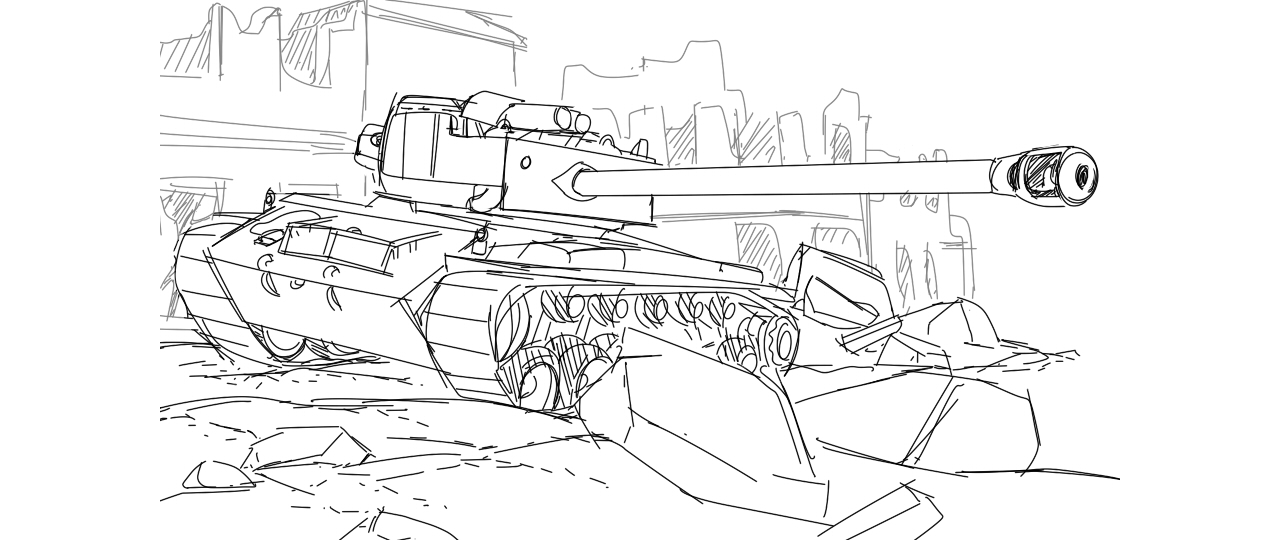Attacking
There are two main modes of attacking for a tank – shooting and ramming. You will (probably) mostly be doing the former. Both methods are explained in the following sections.
As you can see in the table, the farther the target is away, the more powerful your weapon needs to be to hit it.
Bigger tanks are easier to hit. The target’s Size score is subtracted from the base TN.
The TN can never be negative. IF it would fall below 3 when the target Size is subtracted, it stays 3 instead.
A tank that is moving has a harder time hitting things. If you attempt to shoot a target and have used at least your half Speed to move in your turn, you have to add 1 to the TN.
A target that is at least half behind hard cover is harder to hit. Hard cover can be a wall, a rock, or another tank. The TN to hit such a target is increased by 1.
A target of which less than a third is visible behind hard cover cannot be shot, unless the weapon has the Indirect Fire rule.
Finally, apply any feature/defect or item penalties and bonuses. Again, the TN cannot be lower than 3, but it can be higher than 10.
RAMMING
In order to ram you must move at least half of your Speed score in a straight line towards your target. You have to actually be able to reach it within this movement. You don’t have to move your full Speed score, but you must at least spend half of it during this movement. You can’t ram a target if it is closer to you than half of your Speed score. Any remaining unused Speed score is lost for the current turn.
Once the movement is finished, you must make an interaction check. The TN is the target tank’s TN to be Struck attribute. The TN cannot be higher than 10.
If you fail this check, the target managed to evade the collision and nothing happens. Your new position is the target’s original position, and the target’s player or MM can move the target for up to half of its Speed score into any direction.
If you have at least one success, you manage to collide. You inflict DT damage as indicated by your Damage from Strike attribute, including all bonuses and penalties that may apply. This damage is reduced by a value equal to the target tank's Dur+Size score before it is applied.
Additionally, your target inflicts DT damage to you in return if its Size score is equal or greater than yours. This damage is calculated the same as the damage you inflict, but the formula is reversed and the damage is inflicted on you instead. This damage is treated as a Damage from Strike for the purpose of applying bonuses and penalties.
After applying DT damage, if your target hasn’t been incapacitated, you have to determine OST damage. See the section “OST DAMAGE” in the SHOOTING section for more info.
SHOOTING
To shoot a target tank, you need to be able to see it. At least a third of it needs to be visible to your line of sight, unless your weapon has (indirect fire) in its designation. Weapons with the Indirect Fire rule can ignore line of sight if the shooting tank has a different way of knowing where its target is – for example the Artillery Sights feature. These weapons temporarily reduce the target’s Dur score by 2 and ignore cover if fired indirectly. The minimum distance to the target for indirect fire is 100 meters. You don’t have to aim for any target, however. You can also shoot at the ground, into the air, or at any arbitrary point you have a possible line of fire to.
To use your weapon, the following steps are necessary:
- Pick a target. You can only shoot at one target at a time, no matter how many weapons you have equipped.
- Determine modifiers. Your MM decides whether the target has cover, has moved, how far it is away and how big it is, and if any other penalties or bonuses apply.
- Make a roll To Hit. After determining the modifiers, you should have a specific TN. You roll To Hit using 1d10 + your RealityCom score, then add or subtract your To Hit score. You only roll once for all your weapons combined. If you match or beat the TN, your shot(s) hit the target.
- Determine the DT damage. If your weapon’s Firepower matches or beats the target’s Durability score, roll the number of d10 indicated in your weapon’s Damage stat. Take the stated number of dice with the lowest results. The sum of the results is the DT damage you caused. Apply this damage to the target after applying any modifiers. Do this for every weapon you used to shoot.
- Resolve the DT damage. If your target’s DT falls to 0 after applying the damage, it immediately becomes incapacitated.
- Determine OST damage. If your target has any DT left, apply OST damage. For information about inflicting OST damage, see the section further below.
- Resolve OST damage. If your target’s OST falls to 0 after applying the damage, it immediately becomes panicked.
TN TO HIT MODIFIERS
Distance makes its harder to hit targets. The base TN for hitting a target is determined by the distance between the attacker and target:TN to Hit
| Distance | TN | Firepower needed |
|---|---|---|
| < 100m | 8 | 2+ |
| > 100m, < 400m | 12 | 3+ |
| > 400m, < 800m | 14 | 5+ |
| > 800m, < 1200m | 16 | 6+ |
| > 1200m, < 3000m | 18 | 8+ |
| > 3000m | 22 | 8+ |
SIDE SHOTS
If you hit a target’s side or rear, its Dur score is temporarily decreased by 1 for the purpose of determining whether DT damage is inflicted. Indirect shots don’t profit from this rule.OST DAMAGE
OST damage is inflicted during attacks – if you get shot or rammed, your morale might suffer. OST damage can also be inflicted by Intimidation or witnessing an ally getting incapacitated or witnessing an ally panicking. OST damage during a battle can have the following sources:- Being hit by a shot while your current DT is below 8, no matter if the hit causes DT damage or not: 1 point
- Witnessing an ally getting incapacitated or an ally panicking: 2 points
- An enemy intimidating you: 1 point

ATTACKING STRUCTURES
It’s possible to shoot and destroy structures like walls or whole buildings if your weapon has the bunker buster special rule, which is indicated in the weapon’s designation with (bunker buster).
You don’t need to make a To Hit roll to hit structures – proceed straight to determining the DT damage. Structures have a Durability score that you either need to match or beat to damage, and a DT rating that you need to reduce to 0 in order to destroy the structure.
Be careful because collapsing buildings may turn into death traps or cause other collateral damage; this can also be used to your advantage.
OVERKILL
A tank that is incapacitated can still be the target of attacks. Generally, it is completely sufficient to incapacitate a tank to take it out of the battle. Sometimes, you want to make sure it won’t get back up again, ever, though. If a tank’s DT is 0 and it becomes the target of an attack again that would inflict further DT damage, the tank’s player must roll 2d10. On a result of 3+, nothing happens. On a result of 2, the tank’s core is destroyed by the attack and it dies. Permanently.


Comments